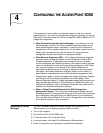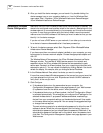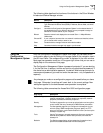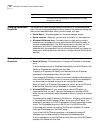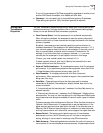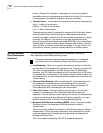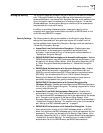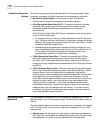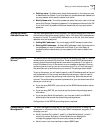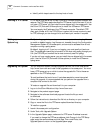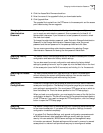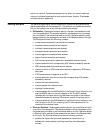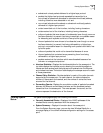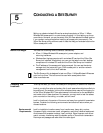
30 CHAPTER 4: CONFIGURING THE ACCESS POINT 8000
Access Point Encryption
Settings
The following encryption settings are available on the Encryption page. These
encryption settings are for Security settings that use access point encryption:
■ No Security (Open System)—No encryption is used. The network
communications could be intercepted by unintended recipients.
■ 40-bit Encryption Shared Key (Wi-Fi)—This option encrypts the wireless
transmissions to protect data, but still permits communication among
compatible wireless LAN clients and access points from third-party
manufacturers.
40-bit Encryption Shared Key (Wi-Fi) security requires you to set up encryption
in one of the following ways:
■ An encryption string is a string of characters between 6 and 30 characters
long. The string can be any combination of letters and numbers and is case
sensitive. The encryption string can be used only with other 3Com 11 Mbps
wireless PC Cards and Access Points.
■ Hexadecimal keys are sequences of hexadecimal digits arranged into four
keys. A hexadecimal digit may be a letter from A to F or a number from 0 to
9. This type of encryption is compatible with equipment from other
manufacturers that use Wi-Fi certified 40-bit encryption.
■ 128-bit Encryption Shared Key—This setting is compatible with 3Com
AirConnect products and products from other vendors, including Agere
and Cisco. 128-bit Encryption Shared Key security requires you to set up an
encryption string or hexadecimal keys as described for 40-bit Encryption Shared
Key (Wi-Fi).
■ 128-bit Dynamic Security Link—This setting requires that you select Access
Point Local Authentication/Encryption option under Security Settings. 128-bit
Dynamic Security Link is the highest level of access point local security,
requiring a user name and password to access the wireless LAN. The user name
and password set up on the access point must match those set up on the
client. Each network session creates a unique, one-time encryption code. If you
choose this type of security, you must also set up the user access list (see
“Setting up a User Access List”). If you check the Require Windows user
authentication check box, clients will be required to enter a user name and
password every time they associate with the network. If you leave this box
unchecked, the system will authenticate clients based on the user access list
and the saved passwords on the clients.
Setting up a User
Access List
The user access list is required only if you configure an access point for 128-bit
Dynamic Security Link on the encryption page. There must be at least one entry in
the List.
The user access list determines which users are allowed to pass data to the access
point. Through this list, you can perform high-level management of up to 1000
user accounts.
■ Adding users—To add a user, you must supply a username and password for
each new user. The username and password pairs must match the user names
and passwords of any clients trying to associate with the access point.




